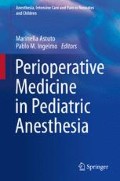Abstract
Chest wall reconstruction for congenital deformities has undergone several technical modifications through the adoption of minimally invasive principles. Nonetheless, postoperative pain remains a key consideration in the management of these patients. This chapter reviews emerging evidence supporting analgesic techniques for the control of early and late postoperative pain after the surgical repair of pectus excavatum (PE) and pectus carinatum (PC).
Access this chapter
Tax calculation will be finalised at checkout
Purchases are for personal use only
References
Kelly RE (2008) Pectus excavatum: historical background, clinical picture, preoperative evaluation and criteria for operation. Semin Pediatr Surg 17(3):p181–p193
Nuss D et al (1998) A 10-year review of a minimally invasive technique for the correction of pectus excavatum. J Pediatr Surg 33(4):545–552
Kelly RE et al (2010) Twenty-one years of experience with minimally invasive repair of pectus excavatum by the Nuss procedure in 1215 patients. Ann Surg 252(6):1072–1081
Fonkalsrud EW, Dunn JC, Atkinson JB (2000) Repair of pectus excavatum deformities: 30 years of experience with 375 patients. Ann Surg 231(3):443
Fonkalsrud EW et al (2002) Comparison of minimally invasive and modified Ravitch pectus excavatum repair. J Pediatr Surg 37(3):413–417
Molik KA et al (2001) Pectus excavatum repair: experience with standard and minimal invasive techniques. J Pediatr Surg 36(2):324–328
Papic JC et al (2014) Postoperative opioid analgesic use after Nuss versus Ravitch pectus excavatum repair. J Pediatr Surg 49(6):919–923
Nasr A, Fecteau A, Wales PW (2010) Comparison of the Nuss and the Ravitch procedure for pectus excavatum repair: a meta-analysis. J Pediatr Surg 45(5):880–886
Kelly RE et al (2007) Prospective multicenter study of surgical correction of pectus excavatum: design, perioperative complications, pain, and baseline pulmonary function facilitated by internet-based data collection. J Am Coll Surg 205(2):205–216
Kelly RE et al (2008) Surgical repair of pectus excavatum markedly improves body image and perceived ability for physical activity: multicenter study. Pediatrics 122(6):1218–1222
Muhly WT, Maxwell LG, Cravero JP (2014) Pain management following the Nuss procedure: a survey of practice and review. Acta Anaesthesiol Scand 58(9):1134–1139
Skouen JS, Wainapel SF, Willock MM (1985) Paraplegia following epidural anesthesia. Acta Neurol Scand 72(4):437–443
Walaszczyk M et al (2011) Epidural and opioid analgesia following the Nuss procedure. Med Sci Monit 17(11):PH81–PH86
Butkovic D et al (2007) Postoperative analgesia with intravenous fentanyl PCA vs epidural block after thoracoscopic pectus excavatum repair in children. Br J Anaesth 98(5):677–681
Peter S, Shawn D et al (2008) Is epidural anesthesia truly the best pain management strategy after minimally invasive pectus excavatum repair? J Pediatr Surg 43(1):79–82
Bogert JN et al (2013) Patient-controlled analgesia-based pain control strategy for minimally-invasive pectus excavatum repair. Surg Pract 17(3):101–104
St Peter SD et al (2012) Epidural vs patient-controlled analgesia for postoperative pain after pectus excavatum repair: a prospective, randomized trial. J Pediatr Surg 47(1):148–153
Stroud AM et al (2014) Epidural analgesia versus intravenous patient-controlled analgesia following minimally invasive pectus excavatum repair: a systematic review and meta-analysis. J Pediatr Surg 49(5):798–806
Qi J, Du B, Gurnaney H, Lu P, Zuo Y. (2014) A prospective randomized observer-blinded study to assess postoperative analgesia provided by an ultrasound-guided bilateral thoracic paravertebral block for children undergoing the Nuss procedure. Reg Anesth Pain Med. 39(3):208–13
Pontarelli EM et al (2013) On-Q® pain pump versus epidural for postoperative analgesia in children. Pediatr Surg Int 29(12):1267–1271
Hall Burton DM, Boretsky KR (2014) A comparison of paravertebral nerve block catheters and thoracic epidural catheters for postoperative analgesia following the Nuss procedure for pectus excavatum repair. Paediatr Anaesth 24(5):516–520
Westphal FL, Lima LC, Lima Neto JC et al (2009) Prevalence of pectus carinatum and pectus excavatum in students in the city of Manaus, Brazil. J Bras Pneumol 35(3):221–226
Martinez-Ferro M, Fraire C, Bernard S (2008) Dynamic compression system for the correction of pectus carinatum. Semin Pediatr Surg 17(3):194–200
Emil S et al (2012) Pectus carinatum treatment in Canada: current practices. J Pediatr Surg 47(5):862–866
Ravitch MM (1949) The operative treatment of pectus excavatum. Ann Surg 129(4):429
Abramson H, D’Agostino J, Wuscovi S (2009) A 5-year experience with a minimally invasive technique for pectus carinatum repair. J Pediatr Surg 44(1):118–124
Fonkalsrud EW, Anselmo DM (2004) Less extensive techniques for repair of pectus carinatum: the undertreated chest deformity. J Am Coll Surg 198(6):898–905
Author information
Authors and Affiliations
Corresponding author
Editor information
Editors and Affiliations
Rights and permissions
Copyright information
© 2016 Springer International Publishing Switzerland
About this chapter
Cite this chapter
Baird, R., Ingelmo, P.M. (2016). Pain After Surgical Correction of Congenital Chest Wall Deformities. In: Astuto, M., Ingelmo, P. (eds) Perioperative Medicine in Pediatric Anesthesia. Anesthesia, Intensive Care and Pain in Neonates and Children. Springer, Cham. https://doi.org/10.1007/978-3-319-21960-8_9
Download citation
DOI: https://doi.org/10.1007/978-3-319-21960-8_9
Publisher Name: Springer, Cham
Print ISBN: 978-3-319-21959-2
Online ISBN: 978-3-319-21960-8
eBook Packages: MedicineMedicine (R0)

